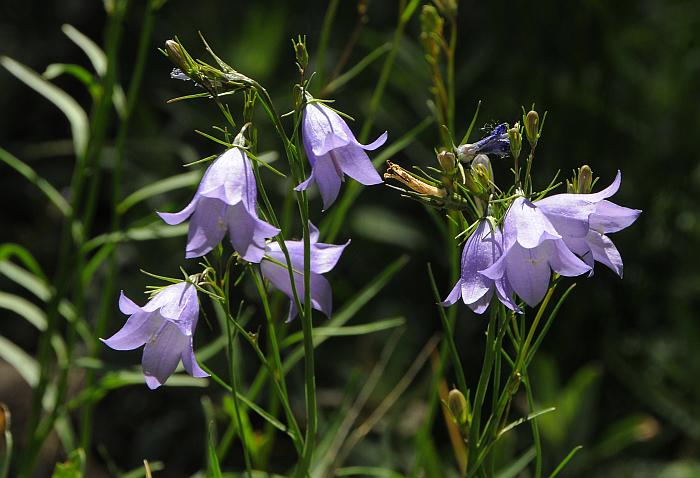Campanula rotundifolia L.
Harebell

Native
CC = 10
CW = 3
MOC = 1
SRank = S1
© SRTurner
Campanula rotundifolia L.Harebell | |
 |
Native CC = 10 CW = 3 MOC = 1 SRank = S1 |
© SRTurner |
|
Family - Campanulaceae Habit - Slender perennial forb, with shallow roots and slender rhizomes and/or stolons. Stems - Loosely ascending to erect, to 70 cm, not reclining on adjacent plants, glabrous or inconspicuously hairy in lines, sometimes sparsely branched toward tip.
Leaves - Basal leaves often absent at flowering, with a long, slender petiole 2-3 cm long, the blade 0.5-1.0 cm long, 0.5-0.8 cm wide, broadly ovate to nearly circular, shallowly cordate, rounded, or broadly angled at the base, rounded or angled to a bluntly or sharply pointed tip, entire or few-toothed, glabrous. Stem leaves gradually reduced upward, long-petiolate to sessile, the blade 3-6 cm long, those of the lower leaves narrowly elliptic to oblanceolate, those of the upper leaves narrowly lanceolate to linear, angled or short-tapered at the base, tapered at the tip, entire, glabrous.
Inflorescence - Terminal racemes or sometimes panicles of 3-8-flowers, the flowers nodding. Flowers - Calyx tube 2-3 mm long, the lobes 4-5 mm long, linear. Corolla actinomorphic, bell-shaped, the tube 6-10 mm long, the 5 lobes 3-4 mm long, light blue to blue. Style 10-11 mm long at flowering, enclosed in the corolla, not elongating markedly as the fruits mature, the stigma usually 3-lobed. Stamens 5. Pistil 1 per flower, of 2-5 fused carpels. Ovules numerous.
Fruits - Capsules, 4-5 mm long, 2.5-3.0 mm in diameter, obconic to narrowly obovoid, pendent, dehiscing by 3 basal pores. Seeds 0.6-0.9 mm long, narrowly ellipsoid, brown, shiny. Flowering - June-July. Habitat - Moist, shaded, north-facing crevices of dolomite bluffs. Origin - Native to U.S. and Eurasia. Lookalikes - Campanula aparinoides. Other info. - This delicate little species has only been reported from one county (Shannon) in Missouri. There it exists along bluffs of the Jack's Fork River, probably as a glacial relict protected and persisting from the time of the last Ice Age, following the retreat of the Pleistocene ice sheets. Though rare in Missouri, it is quite common in states to our west and north. The U.S. distribution is roughly shaped like a gigantic "T", and includes all states along the U.S. northern border (and Canada as well), as well as a perpendicular band reaching down through the Rockies to the Mexican border. The plant is fairly easy to identify from its blue, nodding and bell-shaped flowers and linear upper leaves. However, it does resemble a close sibling, C. aparinoides, which is also quite uncommon in Missouri. This latter plant has weaker stems and leaves with hairs on the margins and midvein. Photographs taken along the Jack's Fork River, Shannon County, MO., 6-22-03, and in Marquette, MI., 9-8-03 (DETenaglia); also in Rocky Mountain National Park, Larimer County, CO, 7-10-2014, 7-31-2017, and 6-23-2018, and Yellowstone National Park, Park County, WY, 7-20-2014 (SRTurner). |